
About UsThe Numismatic Bibliomania Society is a non-profit organization promoting numismatic literature. For more information please see our web site at coinbooks.org SubscriptionsThose wishing to become new E-Sylum subscribers (or wishing to Unsubscribe) can go to the following web page link MembershipThere is a membership application available on the web site Membership Application To join, print the application and return it with your check to the address printed on the application. Membership is only $15 to addresses in the U.S., $20 for First Class mail, and $25 elsewhere. For those without web access, write to: David M. Sundman, Secretary/TreasurerNumismatic Bibliomania
Society AsylumFor Asylum mailing address changes and other membership questions, contact David at this email address: dsundman@LittletonCoin.com SubmissionsTo submit items for publication in The E-Sylum, just Reply to this message, or write to the Editor at this address: whomren@coinlibrary.com
BUY THE BOOK BEFORE THE COINYou won't regret it! |
- WAYNE'S WORDS: THE E-SYLUM DECEMBER 6, 2009
- FANNING AUCTION III SALE RESULTS AVAILABLE
- ILLUSTRATED KOLBE STACK FAMILY LIBRARY CATALOG AVAILABLE ONLINE
- GRADY NUMISMATIC LITERATURE FIXED PRICE LIST AVAILABLE
- PRICE INCREASE LOOMS FOR THE WASHINGTON PATTERN COINAGE OF PETER GETZ
- DENNIS TUCKER'S COSTA RICA REPORT: MUSEO NUMISMATICO IN SAN JOSE
- HOWARD DANIEL'S MUSEUM REPORT: NATIONAL MUSEUM OF INDONESIA
- QUERY: WHO MADE THE MASTERS TOURNAMENT MEDALS?
- ON KOREIN'S COLLECTION GOBRECHT DOLLARS AT THE ANS
- MORE ON HUBERT POLZER
- QUERY: COIN DEALER JAY PARRINO
- MORE ON WALTER BREEN AT JOHNS HOPKINS
- DID THE RUSSIANS INVENT THE DIE-ENGRAVING PANTOGRAPH?
- 1824 HALLORAN SCHOOL PRIZE MEDAL SOLD
- PRINCETON ACQUIRES 7TH CENTURY COIN WITH AN IMAGE OF JESUS
- ANGRY NORTH KOREANS BURN BANKNOTES IN PROTEST
- THE MAGNETIC PERSONALITY OF BIBLIOPHILE ARMAND CHAMPA
- VATICAN COINS COULD BECOME AVAILABLE IN CIRCULATION
- CANADIAN TIRE LAUNCHES $1 COIN
- IDEAL COIN SHOW PUBLICITY: HOUSTON COIN CLUB
- THE LIGHT AT THE END OF THE TUNNEL
- FUNNY CONVERSATIONS BETWEEN BOOK DEALER AND CUSTOMERS
- FEATURED WEB PAGE: FREDERICK MAYER COLLECTION OF COSTA RICAN SILVER COINS
WAYNE'S WORDS: THE E-SYLUM DECEMBER 6, 2009

Among our new subscribers this week are Dave Myers of Teletrade, courtesy of Gar Travis, John Baker, Mark Ghiorso, and I. Karatarakis. Welcome aboard! We now have 1,277 subscribers.
This week we open with a reports on David Fanning's Auction III and the upcoming Kolbe sale of the Stack Family Library. Other topics include Dennis Tucker's numismatic adventures in Costa Rica, dealer Jay Parrino, and bibliophile Armand Champa.
In the news, we discuss articles from around the world on such diverse topics as the 1824 Halloran School Prize medal, Vatican coinage, and a 7th century coin picturing Jesus Christ.
To learn about Peter the Great's cameo-cutting machine and which country's citizens are so mad about their government's currency that they're burning it in the streets, read on.
Wayne Homren
Numismatic Bibliomania Society
FANNING AUCTION III SALE RESULTS AVAILABLE
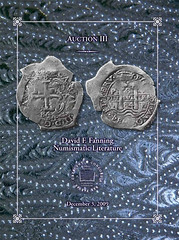 David F. Fanning Numismatic Literature held its third mail-bid auction on December 3. Featuring material from the libraries of John J. Ford, Jr. and Douglas Ball, the sale included many scarce works and specialized studies. A few highlights included:
David F. Fanning Numismatic Literature held its third mail-bid auction on December 3. Featuring material from the libraries of John J. Ford, Jr. and Douglas Ball, the sale included many scarce works and specialized studies. A few highlights included:
Lot 607: A complete, 21-volume set of hardcover Stack's Ford catalogues brought $2500
Lot 375: A 1795 Supplementary Mint Act hand-signed by Secretary of State Edmund Randolph brought $2400
Lot 409: John J. Ford's set of inscribed Red Books (1960-1998) brought $1600
Lot 573: The rare 1917 ANA sale, hand-signed by Wayte Raymond, brought $1300 on a $500 estimate amid heavy bidding
The above are the hammer prices and do not include the 15% buyer's premium.
The complete prices realized list is available on the firm's Web site at www.fanningbooks.com. Our thanks to all who participated.
David F. Fanning Numismatic Literature
PO Box 132422
Columbus, OH 43213
(614) 256-8915
www.fanningbooks.com
ILLUSTRATED KOLBE STACK FAMILY LIBRARY CATALOG AVAILABLE ONLINE
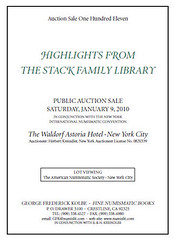 Big E readers might like to know that we have posted at our web site (www.numislit.com), the illustrated catalogue of Highlights from the Stack Family Library, to be sold at public auction in New York City at the Waldorf Astoria Hotel, in conjunction with the New York International Numismatic Convention (NYINC), on Saturday January 9th, 2010.
Big E readers might like to know that we have posted at our web site (www.numislit.com), the illustrated catalogue of Highlights from the Stack Family Library, to be sold at public auction in New York City at the Waldorf Astoria Hotel, in conjunction with the New York International Numismatic Convention (NYINC), on Saturday January 9th, 2010.
The large format catalogue features vintage illustrations of the firm's early facilities, including one of the library, as well as dozens of full color illustrations depicting highlights from the library.
Present as well are a number of interesting articles. After a brief preface, there is a remarkable contribution by William T. Anton, Jr. entitled "Stack's: The Business and Family As I Have Known It for the Past 60 Years." The "Stack Family Tree" is next, followed by a heartfelt account by Michael Hodder of his years at Stack's, and John Dannreuther's "The Inner Sanctum." Former ANS Librarian Frank Campbell has recorded his "Memories of Book Stacks and the Stack's Books."
Finally, P. Scott Rubin has written an extensive history of Stack's, as seen through their auction sale catalogues. At the end of his article is a particularly interesting compilation of the numbers of "Selected Rarities Sold by Stack's" over the years.
Following the Stack sale, one hundred lots of duplicates from The American Numismatic Society Library will be sold in a separate catalogue. ANS will receive the full hammer price of all lots sold.
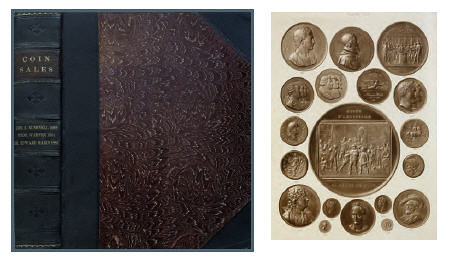
Bill Anton, Jr.:
For those readers attending this unique book auction, it is an opportunity of a lifetime. For decades, the Stack family library was housed in the back office on the wall in front of Norman Stack. Many of the books were handled and used by the greatest numismatists of our era, such as Eric Newman, John Ford, Harry Bass, Lester Merkin, Louis Helfenstein and, last but not least, the late Louis Werner, my Dutch Uncle and Sergeant-at-Arms of the American Numismatic Association.
Michael Hodder:
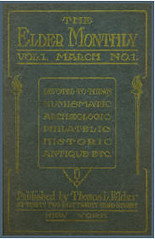 I joined Stack's rather late in the game, in 1992, so I never had the chance to work under Ben Stack and never met the famous Rose who seems to have terrified everyone (except Larry, no one ever frightened Larry), but I was there when the firm began modernizing in a way and I may have been helpful with some of it.
I joined Stack's rather late in the game, in 1992, so I never had the chance to work under Ben Stack and never met the famous Rose who seems to have terrified everyone (except Larry, no one ever frightened Larry), but I was there when the firm began modernizing in a way and I may have been helpful with some of it.
At the time, Stack's was a charming, if sometimes awkward, mixture of the old and the new. We still wrote auction descriptions by hand on white envelopes the way they did at New Netherlands after the war (green envelopes were used for Coin Galleries' lots). Some of the descriptions were transcribed onto paper by typewriter but most were keyed into one of two MS-DOS computers running XyWrite III+, a software program that was already outdated and one that only Martin Gengerke of the firm loved. I was the first staff member, employee or consultant, to be given a laptop on which to catalogue.
The library, represented in the catalogue to hand, was in the partners' office where Harvey and Norman sat across from each other at a substantial partners' desk. At some time in the not too distant past Carl Carlson had been allowed to "organize" the books but since only Carl knew the key to his system no one else could ever find the same book twice.
I had to teach myself to remember where a particular book was by the color of its binding and that of its neighbors. The volumes in this catalogue were Stack's working library and valuable or not, there was never any question raised if someone wanted a book for cataloguing or just to read in a quiet moment, it could be removed and returned when finished.
The closing of the old Stack's really marked the end of the time when coin collecting was still a hobby engaged in by people who really loved numismatics. The dispersal of the family's professional library sets the seal on the closure. I wish neither had happened. For seventeen years Stack's was an important part of my life. The Stack family, Harvey, Norman, Larry, and Susan gave me my chance and I will always be both grateful and indebted to them for it. For their remarkable contributions to American numismatics they collectively deserve the gratitude of the hobby at large. They certainly have mine and my family's.
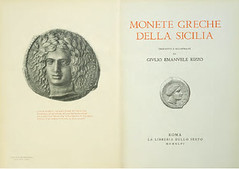
To view the complete catalog, see: www.numislit.com/Sale 111/Sale 111 Stack w-images.pdf
GRADY NUMISMATIC LITERATURE FIXED PRICE LIST AVAILABLE
Numismatic literature dealer O. J. Grady sends this note about his latest fixed price list, available via email.
From time to time we send out a list of inventory in stock. Shipping is determined on a per order basis. Terms of payment are check or credit card via "Paypal". Orders over $200 receive 15% discount.
Orville J. Grady
Numismatic Literature Bought and Sold
705 Howard St.
Scribner, NE 68057
800-295-4846
www.gradybooks.com
PLEASE RESPOND TO: gradybooks@attglobal.net
THE BOOK BAZARRE
Bourne numismatic literature catalogs for sale
Michael and Marlene Bourne, Sales #1 and 2 (complete)
Remy Bourne, sales 1-16 (complete)
Remy Bourne, FPL's Vol I, Nos. 1-2 (complete)
All sales have PR except #16, for which I believe none was issued.
Price for the lot: $135 plus postage.
Denis Loring, dwloring@aol.com
PRICE INCREASE LOOMS FOR THE WASHINGTON PATTERN COINAGE OF PETER GETZ
Until December 31, 2009, the special discounted price for the Spiral-Bound Edition of George Fuld's THE WASHINGTON PATTERN COINAGE OF PETER GETZ is $75.00 per copy postpaid in the U. S. and the Cloth-Bound Edition is $110.00 per copy postpaid in the U. S. California residents must add 8.75% sales tax.
From January 1 to December 31, 2010 copies of the Spiral-Bound Edition will be $100.00 and the Cloth-Bound Edition will be $135.00 per copy postpaid in the U. S., plus 8.75% sales tax for California residents. Copies of the books may be ordered from George F. Kolbe, P. O. Drawer 3100, Crestline, CA 92325-3100. After December 31, 2010, orders for the book will no longer be accepted.
DENNIS TUCKER'S COSTA RICA REPORT: MUSEO NUMISMATICO IN SAN JOSE
I just got back from a (wonderful!) week-long vacation in Costa Rica. Wednesday morning and early afternoon, the day before I returned to the States, I visited the Museo Numismatico of the Banco Central de Costa Rica, in San Jose. I highly recommend the experience. I only wish I'd scheduled the visit earlier in my vacation, because by that time I was tired out from the beach, the clubs, walking around the city, etc.
I spent an enjoyable two hours or so exploring the bank's numismatic exhibits, and if I'd had more energy I would have moved on to the Gold Museum (located in the same complex), to study its collections of pre-Columbian gold artifacts.
I learned a good deal about Costa Rican coins, paper money, and coffee tokens in particular, and I also picked up a few new-to-me Spanish numismatic words.
I bought seven books at the museum. The first six, in no particular order:
- El Papel Moneda, by Manuel Benito Chacón Hidalgo
- La Moneda en Costa Rica, by Manuel Benito Chacón Hidalgo
- Gráfica en el Papel Moneda, 1858 - 1936, by Manuel Benito Chacón Hidalgo and Ileana Alvarado Venegas
- La Casa de Moneda de Costa Rica, 1828 - 1949, by Manuel Benito Chacón Hidalgo
- Resellos de Costa Rica: Costa Rican Counterstamps, by Manuel Benito Chacón Hidalgo
- Monedas de Costa Rica: Reseña Histórica, by Manuel Benito Chacón Hidalgo
and saving the best for last, a beautiful hardcover coffee-table book: Del Real al Colón: Historia de la Moneda en Costa Rica, by Manuel Benito Chacón Hidalgo
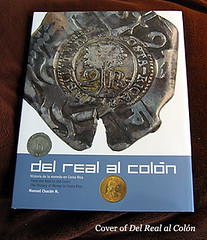
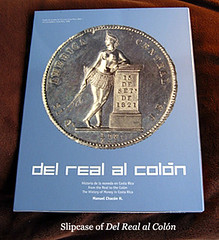

If it seems like Manuel Chacón's name comes up with Bowers-esque frequency, it's with good reason: he's the museum's numismatic curator. His influence is apparent throughout the exhibits, which include a nice overview of several cases of Costa Rican coffee-plantation tokens. One book of his that I didn't buy was Boletos de Cafe de Costa Rica, coauthored with Elisa Carazo de Flores. It weighs in at a hefty 400-plus pages, and I already knew I'd have an overweight charge for my luggage going home. I'll get a copy some day, though, because somewhere in my collection I have some Castella plantation tokens that I acquired years ago.
In addition to the books, I bought a cased sterling-silver Cruz Plata (Silver Cross) commemorating the 150th anniversary of Costa Rica's Campaña Nacional (1856 - 1857) against U.S. adventurer/pirate William Walker and his private army.
An interesting sidebar at the Numismatic Museum was its "hands-on" table, with several trays of old coins, tokens, notes, etc., that visitors are welcome to pick up and examine! I wonder how many casual visitors know to pick up a silver cob or a 1700s piece of eight by its edge, rather than pinched between obverse and reverse.
I also found it fascinating to study the banknote engravings of the American Bank Note Company and other U.S. firms, incorporated into Costa Rica's paper currency. Beautiful pieces of artistry.
Again, I highly recommend a visit to the Banco Central's Museo Numismatico, for any collector who travels to San Jose. It's not a white-sand beach, a wild rainforest, or a packed nightclub, but for a numismatist with a couple hours to spare, it's a unique stop on the Costa Rican itinerary.
HOWARD DANIEL'S MUSEUM REPORT: NATIONAL MUSEUM OF INDONESIA
In the year 2000, I made a trip down to Jakarta to visit with the local numismatic society; the national museum's numismatic department; and the numismatic museum of the national bank.
The society had some great numismatists in it and I was their guest speaker for that meeting. I challenged the members to produce more comprehensive catalogs and that an American or other foreigners should not be writing their catalogs. Four of the members promised me they would work on it.
The national museum has a fabulous collection and the curators all speak English and some other languages besides their own. I am sure they will have the information Jim Duncan is seeking about the Sourabaya Mintmaster. Their website is at http://musuemnasional.org/numismatic.html and their email is musuemnasional@indo.com. Yes, one ends in .com and the other ends in .org.
The national bank's musuem was nice but the staff was mostly into displaying the pieces and not researching them. Their sergeant of the guard at the bank's main entrance also tried to steal my Rolex but I got it back from after a little tussle! He was not a happy camper and I am sure he was the person reporting me to the immigrations and customs people who questioned me at length on my activities in the country and thoroughly searched me and my baggage!
If Jim does not receive a response from the national musuem, the Library of Congress has an office in Jakarta and they are in frequently contact with the museum. The director is an old friend and I will ask him to assist Jim, if he runs into any difficulties.
To read the earlier E-Sylum article, see: QUERY: INFORMATION ON SOURABAYA MINTMASTER JOHANN ANTHONIE ZWEKKERT SOUGHT (www.coinbooks.org/esylum_v12n48a10.html)
QUERY: WHO MADE THE MASTERS TOURNAMENT MEDALS?
Joe Boling writes:
Regarding the maker of the 1940 Masters medal, there is a logo next to the word "sterling" at the bottom of the reverse - whose is it?
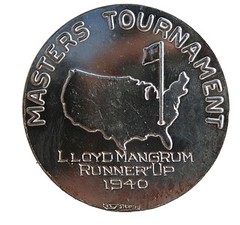
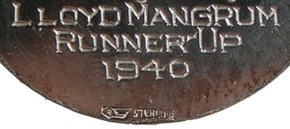
Regarding the article about counterfeiting British one pound coins, Joe has this to say about the article's statement that 'The blanks are squeezed at around 40psi':
To read the earlier E-Sylum article, see: ARTICLE DETAILS BRITAIN'S MUSHROOM FARM COUNTERFEITING OPERATION (www.coinbooks.org/esylum_v12n48a16.html)
ON KOREIN'S COLLECTION GOBRECHT DOLLARS AT THE ANS
Regarding last week's review of the new Gobrecht Dollar book, Dr. Ute Wartenberg Kagan, Executive Director of the American Numismatic Society writes:
I was pleased to see the announcement of Mark Van Winkle's book on the Gobrecht dollars from Dr. Korein's collection. I wanted to add some clarification about the whereabouts of the over 100 pieces, which are described in the release as "now being permanently impounded in the ANS".
Dr. Korein had decided some time before his death to leave his collection to the American Numismatic Society. Neither Robert Hoge nor I had ever met him before the day when he handed over this amazing collection to us. He clearly attended to leave a numismatic legacy in which his name would be associated with research on Gobrecht Dollars. A significant part of the Korein collection is currently on display at the American Numismatic Society.
It is also fairly certain that the collection in its entirety will not remain "permanently impounded" as Dr. Korein left all his lesser die-duplicates to the Society for future sales. Dr. Korein was a professor of neurology at New York University and best known for his work on brain death, in particular, for his testimony in the Karen Ann Quinlan case.
THE BOOK BAZARRE
MORE ON HUBERT POLZER
John Merz writes:
Apropos your consignment to auction of the 3rd & 5th editions of the Redbook inscribed to Hubert Polzer by Yeoman, there are others floating around the numismatic universe. I used to own several Redbooks inscribed to Polzer. Last January, Charlie Davis sold the 10th, 12th, 15th, 17th, 19th, 20th, 22nd and 23rd Editions that I had consigned.
I still have a 1st Edition inscribed to Polzer by Yeoman, which I bought from a Remy Bourne auction about 10 years ago. The best that I could do in Googling Polzer is that he was a coin dealer in Milwaukee, and a former President of the Central States Numismatic Society.
Below are images of Polzer's 3rd edition Redbook, showing the page with Richard Yeoman's inscription. -Editor
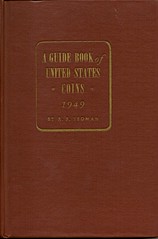
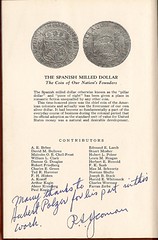
Jeff LaPlante writes:
Mr. Polzer was a past President of the Central States Numismatic Society. He knew Yeoman because they traveled in the same circles. See www.centralstates.info/history6.html
John and Nancy Wilson write:
In the late 1940s & early 1950s when I (Nancy) started to collect coins with my brother, Charles Opitz, we bought all of our coins from Hubert Polzer. He had a jewelry/coin shop in Milwaukee, Wisconsin and attended the Milwaukee Numismatic Society where he met Richard Yeoman. My brother, Charles, and my dad would visit the shop every Saturday or two and buy coins for us. I always insisted that I get the exact same coins as my brother because then I knew I was getting good coins.
Hubert's son-in-law, Pete Forrester, normally waited on us. We each got our complete uncirculated Peace dollar set for $65.00 from him. Our 1940, 1941, & 1942 proof sets were $20.00 for the set of three. He offered us a complete uncirculated type set of U.S. commemorative half dollars for $400.00, but my dad said that was too much. Indian head cents were 75 cents for roll of 50 (1.5 cents each) and my double head Washington cent (1783) in fine condition was $3.00. A proof Stella was $700.00 – I did not get one. I did get a beautiful uncirculated Isabella quarter for $15.00.
Later Hubert sold the coin shop and started to collect antique toys. I saw his collection, which he had in the house next to his residence. It took the whole house to hold the collection.
John and Nancy Wilson add:
To read the earlier E-Sylum article, see: FANNING NUMISMATIC LITERATURE AUCTION III CLOSES DECEMBER 3, 2009 (www.coinbooks.org/esylum_v12n48a02.html)
QUERY: COIN DEALER JAY PARRINO
Speaking of coin dealers, Alan V. Weinberg writes:
Jay Parrino happened upon the numismatic market from almost total obscurity perhaps 2+ decades ago and fast became the single biggest individual personality in commercial numismatics. To my knowledge, he had not been known in the hobby before his sudden appearance and yet within just a few years was buying major collections like the R.E. Naftzger early dates large cent collection from Eric Streiner for well over $5 million.
He bought and sold only the highest quality American coins at then seemingly outrageous prices. Rumors abounded about his background, his source of funds, his apparent excellent taste in numismatics. And then he suddenly disappeared from rare coins, almost overnight. And re-appeared a few years later then, so I've heard, occupying the same prominent market position in rare comics.
Can anyone expound in detail about this man who came a numismatic blazing meteor and then vanished, only to re-appear elsewhere just as prominently ? What's his background, why'd he suddenly leave numismatics, what's his connection with the mysterious, now deceased Southern Californian Iranian numismatic investor Iraj Sayah?
To read the complete article, see: Coin dealer buys Binion's display (www.reviewjournal.com/lvrj_home/2000/Jan-21-Fri-2000/news/12797214.html)
On a related note, Dave Lange writes:
One item from this week's issue caught my attention. It was stated that the million dollar display installed at the Horseshoe Club in 1954 included 100 gold certificates, but this could not have been possible. From 1934 to 1964 it was illegal for individuals to possess gold certificates. Numismatists campaigned for years to get this law overturned, but they were not successful until 1964.
The photo included in The E-Sylum appears to date from the late 1960s, judging by the young lady's hairstyle. When blown up it reveals Federal Reserve notes, with their distinctive bank seals at the left of each note.
Brown, who had purchased the Horseshoe from Benny Binion in 1953, sold his $1 million display in 1959.
In 1964 Benny Binion, who had by then bought back the Horseshoe from Brown, re-created the attraction with another collection of $10,000 bills.
So .. the display pictures the recreation of the original display, which had earlier been sold and broken up. The recreated version, later sold to Parrino, was made up of Federal Reserve Notes. -Editor
Tom DeLorey also had a nit to pick with the newspaper article we quoted. Below is an excerpt. Tom points out that the date mentioned should be 1949, not 1969:
The Treasury Department stopped distributing $10,000 bills, which featured former U.S. Supreme Court Justice Salmon Chase, in 1969. By 2000 only 340 remained in circulation, making the display the most valuable currency collection in the world, according to experts.
To read the earlier E-Sylum article, see: ARTICLE TRACES HISTORY OF LAS VEGAS' MILLION-DOLLAR MONEY DISPLAY (www.coinbooks.org/esylum_v12n48a17.html)
MORE ON WALTER BREEN AT JOHNS HOPKINS
Leon Saryan writes:
When I attended Johns Hopkins as an undergraduate between 1966 and 1970, the BA required 120 credits. For anyone to graduate in ten months having earned that many credits from coursework is inconceivable, unless he entered having received credit for previous work, or tested out of introductory courses. Like every other school, Hopkins had rules, but I know from experience that they also made exceptions. It should be possible to contact the registrar and make an inquiry about Breen's record.
PS. What a clean-cut young man he was in those days!
From Viet Nam, Howard A. Daniel III writes:
I had somewhat of a similar experience as Walter Breen's at Johns Hopkins University, but I was in the Army, just south of him in Virginia. After about ten years straight overseas with six of them in the Vietnam War, I was back in the USA and the Army sent me to one of their schools to catch up on the military training I had missed.
It was January 1973 and the Army was quickly downsizing for the new "peacetime." It was going to be competitive to stay in the Army and it was going to be even more competitive to be promoted, so I quickly realized even senior NCOs would need a civilian education besides their Army education and experience.
When I arrived at my assignment at a Defense Communications Agency laboratory in Reston, VA in the April or May 1973, I started looking around for education opportunities. Everything I could find required me to attend classes in the daytime which was impossible with my duties, so I eventually learned about the Fort Belvoir Education Center. They had such a thing as CLEP Examinations where I could earn 30 semester hours, so I passed all of them. And if I could pass the university/college final exams they had available to them with a high score set by each institution, I could acquire more semester hours without going to class! This was great!
Because of my experiences in the Army and especially in the fast-paced environment in the war, I learned to carefully read and understand large amounts of instructions and information so I could immediately apply them in my work supporting various intelligence activities. My activities were in psywar, politics, history, construction, lines of communications, oil and lubricants, military weapons, ammunition and equipment, maps, satellites, photography, camouflage, biology, animals and insects, diseases.....you name it.
Even during the war, I also received my two periodicals; Scientific American and The Numismatist, and I read them cover to cover. Somehow I had stored all of my past experiences and reading into my brain, plus I went to the local Reston Library and read at least one book on each of the subjects of my tests, which I took two or three of them every two to three weeks. Each test was worth two to four semester hours with most of them worth three.
Of the tests I took over eighteen months, I passed all of them but for two or three where I did not make a high enough score to be awarded the credits without going to class. So I retook those two or three tests after a mandatory waiting period and passed all of them the second time. By the time I departed in December 1975 for another assignment I had acquired 157 semester hours, and I was also newly married and had published my first numismatic catalog. It can be done, but you must put a limit your extracurricular activities!
To read the earlier E-Sylum article, see: MORE ON WALTER BREEN AT JOHNS HOPKINS (www.coinbooks.org/esylum_v12n48a06.html)
THE BOOK BAZARRE
DID THE RUSSIANS INVENT THE DIE-ENGRAVING PANTOGRAPH?
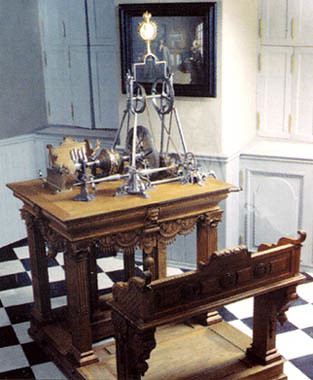 While surfing the internet this week I found an article that blew my mind. It contained illustrations -- both photo and drawing -- of the Russian "medallion engraver" of 1721. The original machine, created by Andrey Kinstantinovich Nartov, was destroyed by fire in 1747 but drawings and the inventor's manuscript were uncovered in Saint Petersburg's National Library that lead a team of mechanics to recreate that original mechanical device 270 years later.
While surfing the internet this week I found an article that blew my mind. It contained illustrations -- both photo and drawing -- of the Russian "medallion engraver" of 1721. The original machine, created by Andrey Kinstantinovich Nartov, was destroyed by fire in 1747 but drawings and the inventor's manuscript were uncovered in Saint Petersburg's National Library that lead a team of mechanics to recreate that original mechanical device 270 years later.
The metal parts of the reconstructed 1993 machine were so precise it worked as well as the original years before. The machine was called the "medallic lathe of Peter the Great," named after its royal patron, who had established a "turnery" where it was first used. This was a studio where artists created small bas-relief objects carved in bone and other materials on a variety of turning lathes.
That original machine was described in detail by inventor Nartov in his 1755 manuscript, "Teatrum Machinrum," which could also be another name for the machine. The article also calls the reconstruction a "medallic-copier lathe." It has also been referred to in print as a "medallion engraver." With all these names one might expect this contrivance was the earliest "holy grail" sought by hand engravers for centuries -- a machine that eliminated the tedium of hand engraving.
Not so. Today we can best describe Nartov's creation as an elaborate "cameo cutter."
Cameos have been known since ancient times, originally carved by hand, much like dies were hand engraved. However dies were cut negative to strike positive images, cameos were carved positive, one at a time, without any means or necessity of replication. The first cameo cutting innovation was to power the drill bit with a bow. Imagine a Boy Scout using a bow to start a fire. The bow string wrapped around the drill rotated it as the bow was applied back and forth.
What Nartov may have invented was the foot power applied to his elaborate lathe (like a foot-powered sewing machine of the 19th century). Amazingly the foot power mechanism is missing from both photo or drawing, but the attached article mentions a mysterious "foot gear." We observe the chuck where the discs to be carved were affixed and the spindle where the cutting point was placed. But we see no provisions for any pantographic reduction.
In Peter's workshop "turnery" artists cut objects in bone, even from mammoth tusks, as they may have had on hand a considerable supply of these. A few were even cut in metal, as a portrait mold (obviously for casting) is shown in the article. There is no evidence, however, a die was cut in this workshop which could have been used for striking. (Such technology could have cut a die, however; it would be unusual for this to be overlooked.) But without this evidence we must class Nartov's machine as a cameo cutter. Thus it cannot be classed as a die-engraving machine.
One of Nartov's machines was in a Paris museum. I had reference to this in my notes (where I learned of this in the Oxford publication A History of Technology by Singer and others, vol 4). In a study of the die-engraving pantograph, I noted Nartov's machine was a precursor, along with cameo cutters developed in other countries, notably Britain and France. The first truly engraving machine was the Belgium Hulot of 1766 (documented in Denis Cooper's Art & Craft of Coinmaking, illustrated page 166). This machine had peddle power and was followed by minor improvements by Frenchmen Mercklein (1767) and Dupeyrat (ca 1788).
The second generation of engraving machines was powered by waterwheels and belting until Mathew Boulton and James Watt added steam power to their engraving machine at the Soho Mint in 1790. The fourth generation was dominated by Victor Janvier who started experimenting in 1892 with his improvements (twin cone drives of the cutting tool and the speed of the rotating pattern and diestock) and patented his miracle machine in 1899. I wrote more extensively on the die-engraving pantograph in The E-Sylum March 14, 2004.
To answer the question posed in the headline: No. Nartov's machine was not a die engraver, but only a cameo cutter. The invention of the die-engraving pantograph clearly rests with Hulot of Belgium. I wish we knew his full name -- he deserves the credit! (Alphée Dubois did an 1875 portrait medal of "M. Hulot;" is this our inventor? Forrer's Biographical Dictionary, 1:631).
But of all these engraving machines the best was Janvier's machine. Mints of the world beat a path to his Paris factory to obtain his die-engraving pantograph.
To read the complete article (it's in English), see: Peter the Great's ornamental turning lather (www.mokeeva.com/e-machine.htm)
To read the earlier E-Sylum article, see: THE JANVIER DIE-ENGRAVING PANTOGRAPH (www.coinbooks.org/esylum_v07n11a10.html)
1824 HALLORAN SCHOOL PRIZE MEDAL SOLD
They say that every object carries a story, well this curious object has more than most! The school prize medal looks ordinary enough at a first glance, but it is its background that has sparked interest nationwide.
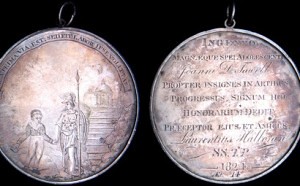
The silver engraved 1824 "Halloran School Prize Medal" was previously owned by a private UK collector who has now put it up for auction. There are only five others similar to it.
It was presented to a 14 year old schoolboy by the name of John Dawning Tawell, an immigrant to Australia from the UK who had only arrived in Sydney the previous year. Tawell received his medal from the notorious Laurence Hynes Halloran.
Posing as a chaplain, he served on the Brittania at the Battle of Trafalgar. He then lived in South Africa for a while where he was banished and heavily fined for defamatory libel upon publication of a satire on South African Characteristics.
Halloran returned to England but trouble followed him and he was found guilty of forgery and sentenced to seven years transportation.
Halloran immigrated to Australia in 1819 and there helped establish a private school that eventually became known as Sydney Grammar School.
The boy who received the coveted medal had an equally notorious father. Mr Tawell Snr was sacked from his job as a Quaker Linen-Draper for the seduction of a young housemaid who subsequently fell pregnant. He turned to forgery and was transported to Australia from the UK. He made his fortunes in the pharmaceutical business and encouraged his family to join him, which is when young John Tawell arrived in Sydney. However the good life did not last long and Mr Tawell Snr was arrested after poisoning one of his mistresses and was later hanged at Aylesbury in 1845. He was the first man to be caught by newly installed telegraph wires which allowed police to communicate with each other his whereabouts.
So how many of them collect Australian medals? What about school medals? Aha! I thought of a possible suspect. So at about 10pm Thursday I emailed the collector about the medal and asked "Was it you?" Within minutes I had a reply from their iPhone: "Y". Bingo!
I won't out anyone without their permission, and in a subsequent email the collector, a longtime E-Sylum reader and contributor, agreed. The buyer was John Sallay of NeoCollect.com, who displays his collection of school-related medals on the site. -Editor
John Sallay writes:
Yes, I thought it was very interesting on a number of dimensions - great story, great iconography, signed by the engraver (with his own very interesting story), and a real piece of Australian history.
The price was an order of magnitude higher than what a comparable British or perhaps even American school medal would have cost, but another example sold two years ago in a Noble Numismatics auction in Melbourne for roughly the same price.
My wife is a very understanding person...
To read the complete article, see: Piece of Australian Notoriety Goes Up For Auction (http://www.embraceaustralia.com/piece-of-australian-notoriety-goes-up-for-auction-5354.htm)
The medal ... was bought by a private American collector whose bid exceeded the expected $A21,565 to $A26,956 sale price.
Auctioneers Morton & Eden uncovered the medal's history after a British private collector approached them wanting to sell the valuable item.
A spokesman described the auction as a "great result", even though a bit disappointing that an Australian collector isn't the proud new owner of the medal.
"It's a very special object," Chris Proudlove said.
Murder and mayhem linked to rare medal
(news.theage.com.au/breaking-news-world/
murder-and-mayhem-linked-to-rare-medal-20091203-k6oz.html)
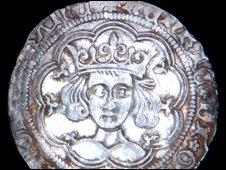 A hoard of silver coins hidden in a Northamptonshire field during the Wars of the Roses has fetched more than £29,000 at auction.
The 186 coins, found in Brackley in 2005, were sold at Morton and Eden by the metal detector enthusiast who found them and the owner of the field.
A hoard of silver coins hidden in a Northamptonshire field during the Wars of the Roses has fetched more than £29,000 at auction.
The 186 coins, found in Brackley in 2005, were sold at Morton and Eden by the metal detector enthusiast who found them and the owner of the field.
It is thought they were hidden in the summer of 1465 by someone who went into hiding during the dynastic civil war. They were sold in separate lots for £29,900 at the auction house. Jeremy Cheek, from the specialist auctioneer, said the coins represented a "sizeable stash of money" at the time.
To read the complete article, see: Wars of Roses silver coins fetch £29,000 in auction (news.bbc.co.uk/2/hi/uk_news/england/northamptonshire/8391439.stm)
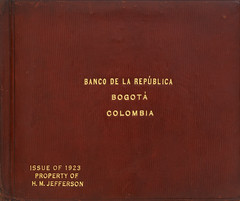
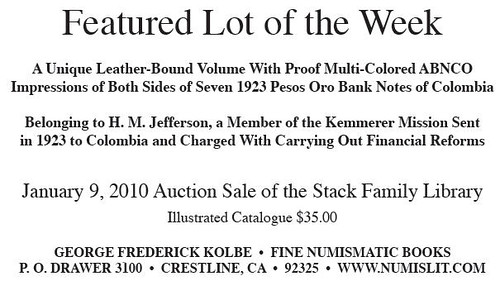
PRINCETON ACQUIRES 7TH CENTURY COIN WITH AN IMAGE OF JESUS

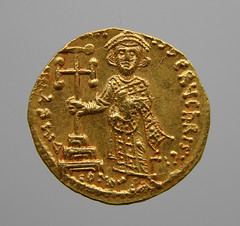
It's not the kind of coin you'd want to plunk into a soda machine, nor is it the kind you'd find while digging around under your couch cushions.
It's a Byzantine gold coin from the seventh century with an image of Jesus Christ on its face, issued by Emperor Justinian II. It's the first known coin to have a Christ image, and it now has a new home in the Princeton University Numismatic Collection.
It's a high quality specimen that Alan Stahl, the university's curator of numismatics, said he had been seeking for several years, only to be outbid at auction again and again.
"Finally, a dealer with whom I'd placed a bid a couple of times found one in a private collection and offered it to us at a reasonable price."
The coin has been dated to the year 692.
According to Stahl, the Princeton University's numismatic collection contains about 100,000 items and is reputed to be the oldest institutional collection in the country.
He said the gold coin was a specimen valuable not only in terms of the coinage of the eastern Mediterranean in the Middle Ages, but in the history of all coinage.
"The most important thing is that it's the first time the image of Christ is used as the main image on the coin," he said. Until this time, most coins had only featured portraits of the period's ruling emperor. In this case, Justinian II was cast on the reverse of the coin.
And while this may seem like a benign bit of imagery to us today, it sent shock waves across the region in its time.
"This was considered really shocking in its time, and it got reactions all over," he said.
To read the complete article, see:
Princeton acquires coin with an image of Jesus from the 7th century
(www.nj.com/news/times/regional/index.ssf?/
base/news-18/1259909134180700.xml&coll=5)
ANGRY NORTH KOREANS BURN BANKNOTES IN PROTEST
Loren Gatch writes:
To curb unauthorized market activity, the North Korean government has forced a revaluation of the currency, lopping off two zeros from old denominations and limiting the ability of people to change old money supplies for the new notes.
The effect will be to sharply reduce the money supply, effectively confiscating the balances of black market traders.
The things you can do when you run a dictatorship! Gorbachev pulled off something similar in Russia in 1991.
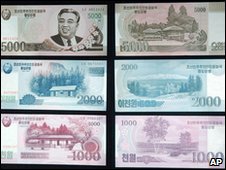 People in North Korea have been setting fire to old notes of the national currency, the won, a report says.
People in North Korea have been setting fire to old notes of the national currency, the won, a report says.
The Daily NK website said people had been burning piles of old bills in anger over the government's reported redenomination of the currency. The move is said to have knocked two zeros off the nominal value of each banknote, although Pyongyang has not confirmed the action. An image of the new notes has appeared in the Japan-based Choson Sinbo paper.
North Korea's official media has kept quiet over any reform of the currency, but newspapers based in South Korea and Japan have said that the government informed citizens and foreign embassies of the move on Monday.
To read the complete article, see: North Korea currency reform sparks anger (news.bbc.co.uk/2/hi/business/8395268.stm)
THE MAGNETIC PERSONALITY OF BIBLIOPHILE ARMAND CHAMPA
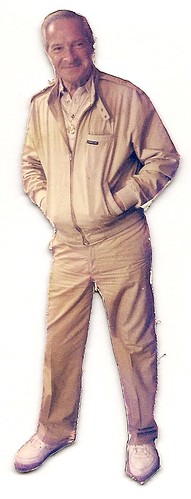 Several years ago the Numismatic Bibliomania Society raised $3,000 to endow a new exhibit category for numismatic literature at conventions of the American Numismatic Association. My memory of events is getting hazy, but I recall that we raised some of the funds with an auction of donated items at our annual meeting. My donation was a gag, but I think it ended up raising a few hundred dollars.
Several years ago the Numismatic Bibliomania Society raised $3,000 to endow a new exhibit category for numismatic literature at conventions of the American Numismatic Association. My memory of events is getting hazy, but I recall that we raised some of the funds with an auction of donated items at our annual meeting. My donation was a gag, but I think it ended up raising a few hundred dollars.
Having visited famed numismatic bibliophile Armand Champa at his Louisville home, I had a photo of him I'd taken with my camera. On a whim, I took the picture to a photo shop and had it made into three refrigerator magnets. We sold them at the meeting.
I'd almost forgotten about these until the other night, when my five-year-old daughter Hannah was playing in my home office and found my copy of the magnet attached to the side of my file cabinet. She had Armand in one hand and a toy in the other, having a nice conversation among themselves. She didn't want to give him up, but I didn't want my souvenir of a good friend to get lost or broken. I had to chase Armand into the next room, but I managed to get him back in one piece and restored him to his Place of Honor after scanning the image you see here.
So, did I get my facts straight? And what happened to the other Armand Champa refrigerator magnets? Anyone know?
THE BOOK BAZARRE
VATICAN COINS COULD BECOME AVAILABLE IN CIRCULATION
Coin collectors eager to get some Vatican euros without the tourist markup may soon be able to thank Brussels for nudging the Holy See to issue some of its money as real money. Nearly all of the euro coins minted every year with the image of Pope Benedict are sold to collectors. They go at the Vatican souvenir shop for 30 euros a set, which is already a tidy markup from their 3.88 euro face value. What's worse, they can be hard to find, which means many end up on a secondary market where the sets go for multiples of their original sale price. Here's one on sale on the Internet for 89 euros, another for 99 euros. Prices are probably higher in coin shops.
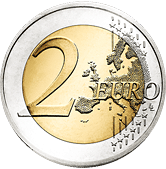
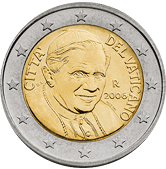
The European Commission took up this issue last July when it asked the European Central Bank (ECB) for advice on renegotiating the monetary agreement the EU has with the Vatican City State allowing it to use the European currency. Before the euro was introduced, the world's smallest state issued its own lira similar to the Italian lira. The Vatican has the right to issue 1,074, 000 euros in coins per year.
The ECB recently released its recommendation saying the Vatican should circulate at least 51% of the coins it issues and suggests a joint committee to ensure this and other agreements between Brussels and the Holy See are actually implemented.
So will the Vatican lose out on this tidy little business? No, it seems that someone in Brussels has thought about that as well. The Commission report, which my Frankfurt colleague Sakari Suoninen dug out for me, suggests the Vatican's quota for issuing coins annually could be almost double to 2,100,000 euros. If that happens, it could continue to issue almost as many collectors' sets and still circulate over a million euros in coins. Tourists might even get some in change at the souvenir shop.
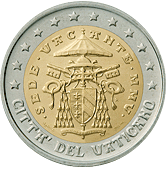 There was apparently a move last year in Brussels to stop the Vatican from issuing special "sede vacante" (empty seat — see image at right) coins during a papal interregnum, for example between the April 2 death of Pope John Paul and the April 19 election of Pope Benedict in 2005. Those rare coins, bearing the emblem of the Apostolic Chamber and the coat of arms of the cardinal chamberlain (camerlengo, or acting head of state), are worth much more — here's a set going for 395 euros on the collectors' market. But the Commission report says the Vatican can continue producing these instant rarities
There was apparently a move last year in Brussels to stop the Vatican from issuing special "sede vacante" (empty seat — see image at right) coins during a papal interregnum, for example between the April 2 death of Pope John Paul and the April 19 election of Pope Benedict in 2005. Those rare coins, bearing the emblem of the Apostolic Chamber and the coat of arms of the cardinal chamberlain (camerlengo, or acting head of state), are worth much more — here's a set going for 395 euros on the collectors' market. But the Commission report says the Vatican can continue producing these instant rarities
To read the complete article, see:
Hope for new Vatican coins without the tourist markup
(blogs.reuters.com/faithworld/2009/12/01/
hope-for-new-vatican-coins-without-the-tourist-markup/)
CANADIAN TIRE LAUNCHES $1 COIN
 Some Canadian Tire shoppers were scratching their heads with confusion on Wednesday after the iconic retailer took a cue from the loonie and temporarily introduced a dollar coin to its famous multicoloured bill lineup.
Some Canadian Tire shoppers were scratching their heads with confusion on Wednesday after the iconic retailer took a cue from the loonie and temporarily introduced a dollar coin to its famous multicoloured bill lineup.
The coins will be available for hardly a weekend, arriving at stores in most parts of the country on Saturday and ending their run on Sunday, but the publicity is intended to drum up interest during the crucial holiday shopping season.
However, if comments outside a Canadian Tire store in Toronto are any sign, not everybody likes the change.
"I've got lots of paper money, and now I've got this in my pocket? It looks heavy," said Victor Baptista as he handled the coin.
"Most of mine I lose... or it just gets stored. My drawer is full of them."
The "money," which can be used like cash only at Canadian Tire stores and gas bars, was previously available only in bill form in denominations from five cents to $2, all stamped with the grinning image of Sandy McTire, the company's tam-o'shanter-bedecked and mustachioed fictional mascot.
The new silver coin has McTire on one side, and is emblazoned with the Canadian Tire logo on the other. Just like its official cousins, the loonie and the toonie, the coin will be manufactured by the Royal Canadian Mint.
While the coin is only available at Canada's largest hard goods retailer for a couple days, it marks a major shift for the half-century-old Canadian Tire Money, which has until now never strayed from its papered roots.
To read the complete article, see:
Canadian Tire launches limited edition $1 coin
(www.ctv.ca/servlet/ArticleNews/story/CTVNews/20091202/
canadian_tire_091202/20091202)
In a digital economy, Canadian Tire money is quite literally throwback to an era of physical cash and human interaction that scarcely exists in this online age of speedy and efficient consumption.
But a decision to cancel the paper money program would surely shock the nation - not least, the money's ardent collectors - even if the retailer has already moved to a parallel electronic rewards program using a credit card and electronic Canadian Tire money.
"They may be cutting back their printing costs while at the same time not eliminating Canadian Tire money altogether, but replacing say, the 50 cent, dollar, and two dollar (bills) with a coin," Fox said, adding, "I'm just thinking out loud, that's all. I have no proof."
Canadian Tire has been making a gradual shift away from emphasizing its paper money.
Canadian Tire rolls out new dollar coin
(www.thestar.com/business/article/733544--
canadian-tire-rolls-out-new-dollar-coin?bn=1)
IDEAL COIN SHOW PUBLICITY: HOUSTON COIN CLUB
Dick Johnson writes:
Good coin show advance publicity concentrates on a theme and illustrates a coin that captures the interest of the public with just enough numismatic facts to lure collectors and public alike. The Greater Houston Coin Club's show publicity did just that for their Money Show of the Southwest this weekend. Publicity chairmen for coin shows should copy this article and note well a model they could emulate for future shows.
 It's just a common looking penny with Lincoln on the front and wheat ears or stalks on the back. Did I say it's made of copper and had the date, 1943, to the right of Lincoln? Whoops, that makes this coin one of the ultimate in errors made by the United States Mint, and its value jumps from one cent to about $250,000.00!
It's just a common looking penny with Lincoln on the front and wheat ears or stalks on the back. Did I say it's made of copper and had the date, 1943, to the right of Lincoln? Whoops, that makes this coin one of the ultimate in errors made by the United States Mint, and its value jumps from one cent to about $250,000.00!
Wow, that sure isn't common!
All but one of the currently known examples of this true rarity were pulled from circulation by alert collectors. As the coins from penny jars of older generations find their way into circulation, there could be another 1943 copper penny lurking in merchants' cash drawers!
So keep your eyes open and check your change. If you find a penny that looks copper in color and has "1943" to the right of Lincoln, bring it to the Money Show of the Southwest at the George R. Brown Convention Center, this Thursday through Saturday, Dec. 3-5. Who knows, you may be the next lucky person to claim the rare coin jackpot!
If your discovery isn't the real thing, you can still get up close and personal with the $250,000.00 example as it is on public display from this Thursday to Saturday.
And by all means, if you see a penny on the ground, be sure to pick it up. Who knows, it could be your lucky day!
To read the complete article, see:
Houston Coin Club's ‘Money Show" Dec. 3-5
(www.hcnonline.com/articles/2009/11/30/greater_houston
_weekly/top_of_the_week/1202_coin_club.txt)
THE LIGHT AT THE END OF THE TUNNEL
Important Notice:
Due to recent budget cuts, the stock market crash, and the rising cost of electricity, gas, and oil, the light at the end of the tunnel has been turned off.
We apologize for the inconvenience.
Sincerely,
The Government
FUNNY CONVERSATIONS BETWEEN BOOK DEALER AND CUSTOMERS
(phone call)
Do you buy books?
Yes. What do you have?
Reading books.
Reading books?
Yea. Books you read.
Ok. But I am not sure what it is you have.
I just said. Reading books. Do you buy them?
No. Thanks for calling.
____________________________________________________
Are these books old, or do you make them look old?
We have a special spray that makes new books look old and old books look new.
Really?
Yea.
Can I get some?
No, my distributor only sells to book dealers.
____________________________________________________
I am looking for a certain autobiography, but I don't know who the author is. Can you help me?
That might be difficult!
____________________________________________________
(customer standing on top of an old, oak library ladder)
If I was your attorney, I would make you get rid of this ladder.
If you were my attorney, I'd push you off it!
____________________________________________________
Are these books for sale, or do you just collect them?
____________________________________________________
(phone call)
I found a book "---" on your web site. It was written by my Uncle. I was wondering why it is so expensive? ($50)
It was inscribed and signed by him.
Why should I have to pay for his autograph? He's my Uncle, not yours!
(sigh... and no, she didn't buy it)
____________________________________________________
(Older gentleman calls)
I see you have a book titled "---" listed on your web site for $200
Ok
I am the author.
Ok
That book originally sold for under $20
Ok
How can you justify that?
Justify what?
Charging so much!
That's what it's worth. Look it up on Bookfinder
You will make more on the book than I did
I guess I should feel bad about that! If it makes you feel better, you could adjust for inflation (30 years)
It just doesn't seem right
It's the free market at work. You shouldn't have written such a good book
So where were all these buyers when the book first came out? If I've done anything right as a numismatic bibliophile, it's been to always buy a copy of a book right when it comes out. Sure, maybe I could get it cheaper in the aftermarket. But maybe it won't be available, either. Time and again I've bought numismatic books that end up having low print runs and eventually jump to values several times the original price.
So here's a hint, buckaroos. If you have any interest at all in early U.S. coinage, scroll up to the article about George Fuld's new book on the Getz coinages, and order one. I did. -Editor
To read the complete article, see: The BookMine - Stupid Quotes (www.bookmine.com/stupid.php)
FEATURED WEB PAGE: FREDERICK MAYER COLLECTION OF COSTA RICAN SILVER COINS
This week's Featured Web page is a 2008 CoinLink article by Greg Reynolds on the auction of the Frederick Mayer collection of Costa Rican silver coins.
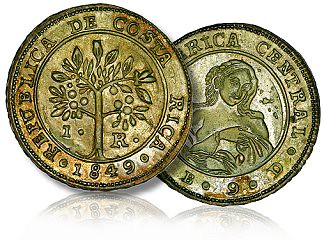
Costa Rican silver coins of the 19th century are often confusing because the monetary system was changed four times. The first system stemmed from that of the Spanish Empire. Sixteen silver reales equaled one gold escudo. The Eight Reales silver coins, of the Spanish Empire, were the basis for U.S. silver dollars.
The term ‘two bits' refers to Two Reales coins which were about equivalent to U.S. quarters. From the 1790s to the 1830s, U.S. quarters were not often seen in circulation in the U.S., and Two Reales coins of the Spanish Empire served as quarters in the U.S. It was very common then for Two Reales coins to be given in change when purchases were made with U.S. half dollars or gold coins. Indeed, the silver coins of the Spanish Empire circulated widely in the U.S. at least until the 1860s, and circulated to some extent in the West until the 1880s.
In the 1840s, there were probably more Spanish Empire silver coins in circulation in the U.S. than there were U.S. Liberty Seated coins. One Real could be thought of as being worth around 12½ U.S. cents. A Four Reales coin thus paralleled a U.S. half dollar. Coins of the Spanish Empire and their direct descendants are very much a part of the monetary history of the United States.
www.coinlink.com/News/world-coins/
the-greatest-collection-of-costa-rican-coins-ever-
auctioned-part-2-silver-coins-of-the-1840s/
